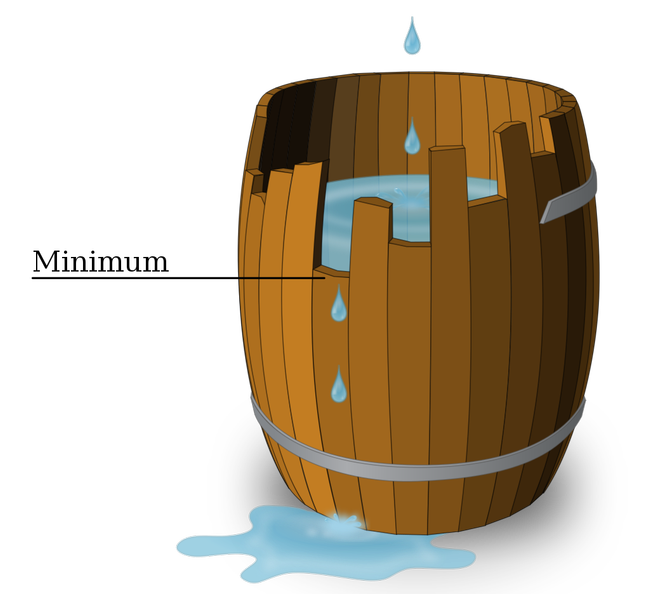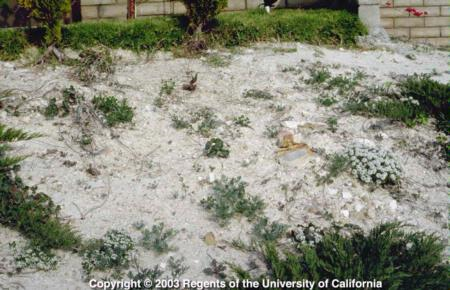
Posts Tagged: iron
Copper? On Your Avocado Trees?
At a recent Fresh Index-sponsored meeting, David Crowley recently of UC Riverside talked of a five year-long study that assessed nutritional status and yield. This has been a study area that has long been confused by the problems of alternate bearing, weather-dependency of the avocado, soil variability, root rot, etc. etc. etc. that we all know about. There are nutrient interactions that confound results, as well. High phosphorus affects micronutrient uptake of zinc, copper and others. Zinc impedes copper uptake. Loss of roots from Phytophthora especially affects micronutrients. Irrigation and aeration again affects nutrient uptake, and especially micronutrients.
The elements coming from the soil are divided into primary nutrients, secondary nutrients and micronutrients. This grouping is based on the relative amounts required by plants, but all are essential. Crowley describes the relative need for each element being based on the “Law of the Minimum”; if only one element is deficient it eventually affects growth and yield of the entire plant in a negative manner. It doesn't matter how much the other nutrients are raised, if one is limiting, growth is limited by that one. The primary nutrients required by avocados are nitrogen, phosphorus and potassium. The secondary nutrients required are calcium, magnesium and sulfur. The micronutrients are zinc, iron, manganese, copper, boron, molybdenum, nickel and chlorine.
The Law applies not just to nutrients but to light, temperature, water, disease, pests – anything that affects growth. The limiting input needs to be fixed before the others can boost growth to whatever the biological maximum might be in that environment. In irrigated agriculture, water is the most common limiting input.
So, it is complex. Really complex. But with computers and different techniques of analysis and just looking at nutrients, Crowley has been able to get a better handle on what could be limiting growth in an individual grove. This applies not to what is lacking, but what might be in excess – too much chloride, too much nitrogen, too much…………….
So, in the case of all this data collection the Crowley team has done, something unusual has popped up. Copper deficiency.
Copper deficiency is not commonly recognized as a problem in California avocado groves, but occasionally a grower will report a leaf analysis showing less copper than the 5ppm recommended by Embleton (http://ucavo.ucr.edu/General/LeafAnalysis.html). Typical copper deficiency was reported by Barnard and others (http://www.avocadosource.com/Journals/SAAGA/SAAGA_1991/SAAGA_1991_PG_67-71.pdf). They reported the symptoms of copper deficiency as follows: • Dull appearance of older leaves • Prominent leaf veination • Reddish-brown leaf color • Premature defoliation and twig. This is an extreme case, and Crowley is suggesting there may be some low, chronic level that limits avocado. His final report can be found at:
Of course, why copper might be limiting is another question. Is it due to root rot? Interaction with other applied materials like phosphorus (not phosphite, phosphorous, phosphonate) fertilizers? With irrigation management? Something(s) to think about.
And citrus in California is a different beast. It can commonly show copper deficiency and be a limiting nutrient. We apply copper as a frost/brown rot/septoria spray and as a result don't often see deficiency in citrus.
Image
Liebig's Barrel. Optimum production occurs when all the barrel staves are as high as they can be. When one element is low, that becomes the limiting factor for production. Increased production doesn't occur until that uptake is improved and then the next limiting input restricts production. When that next one is corrected, then some other input then limits production. Correction keeps improving production until the biological limit is reached.
Have any readers actually seen a wooden barrel?

minimum nutrient
Calcareous Soil Confusion
Calcareous soils have often more than 15% CaCO3 in the soil that may occur in various forms (powdery, nodules, crusts etc…). They are relatively widespread in the drier areas of the earth. California is notable for its young soils, that is, soils that have a relatively high level of nutrients because low rainfall means that natural productivity has not been leached out. The potential productivity of calcareous soils is high where adequate water and nutrients can be supplied. Water is the most limiting input to making California soils productive.
The high pH associated with these soils, though, is not the level of calcium present. It is the carbonate in the soil or the bicarbonate associated with the waters found in those soils which controls the pH. The high pH then controls the availability of iron, zinc, manganese and copper. These nutrients need to be added as foliars or soil applied, or better yet, the soil pH needs to be dropped to around 7 to make these nutrients available.
Recently someone asked if replacing the calcium with potassium would change the pH. No, it won't. The carbonate needs to be removed. Calling it a calcareous soil confuses people about what caused the high pH. The carbonate or bicarbonate needs to be removed with acidification, it turning it into CO2 gas. This is done with urea sulfuric acid or sulfuric or sulfurous acid. There are actually magnesium dominated soils in the San Luis Obispo area that have high pHs due to carbonates. They are carbonateceous.

calcareous soil
Zinc and Phosphorus
I was recently in an avocado orchard and saw the rounded fruit and small leaves typical of zinc deficient trees. I asked the grower if there were recent leaf analysis of the orchard, and so we looked at them. The leaves were running at 20 ppm which is low. Sufficiency runs at 50 ppm. The recommendation was to apply zinc sulfate to the soil. The recommendation included, though 200 pounds of phosphorus per acre. Phosphorus and zinc are antagonistic, meaning applying one can limit uptake of the other. In applying phosphorus at such a high rate was probably preventing uptake of zinc. It is also antagonistic to copper, iron and manganese, so all of these micronutrients can be limited by phosphorus applications.
There have only been two documented cases of phosphorus deficiency in fruit trees, walnuts on a volcanic soil in Lake County and oranges on decomposed granite in San Diego. It is an essential element, yes, but applying it when there is sufficiency in the leaves can lead to other problems which can be hard to correct. Generally speaking, phosphorus does not need to be applied to fruit trees in California. In other states that have peat soils, high carbonates or highly weathered soils, phosphorus application is a normal practice, but here make sure you need it before applying it.
When to Fertilize Avocado and Citrus in California
Citrus and avocado are of subtropical and tropical origin are cold-tender plants that have not developed the effective cold hardening process of deciduous trees that drop their leaves and go dormant. Even within deciduous, temperate tree species there are ranges of frost tolerance. Subtropicals do have the capacity to develop some cold tolerance and this is by going through quiescence, a sort of resting condition of no or slow growth when cooler temperatures arrive. Quiescence is induced several weeks after 40-50 degree F temperatures arrive. Cold tolerance develops most when trees are not flushing. The healthier and less stressed the tree, the more responsive it is to the cooler temperatures that induce quiescence. A tree that has been recently pruned or nitrogen fertilized is more likely to continue flushing through the cold-induction of early winter and is more subject to cold damage. Unfortunately along the coast, there can be warm temperatures that occur during the winter. This can break quiescence and the trees start flowering or flushing and when cold weather arrives again, the trees are now more susceptible to cold.
Because an evergreen canopy like avocado continues to transpire, the roots of subtropicals continue to operate to deliver water to the leaves. The leaves though are not doing much other than losing water. Therefore, there is not much demand nutritionally on the part of the tree. In fact, fertilizing with nitrogen can break the quiescence and make the tree more susceptible to cold. The tree already stores the bulk of its nutritional needs in the roots, branches, stems and leaves and can call on nutrients if it needs them. Supplemental fertilizer at the time of quiescence, though, can result in an excess of the tree’s needs and induce flushing. The goal is to go into winter with adequate storage, so that when spring comes, the nutrients are there for the demanding flowering period. Adequacy is based on previous fertilizer applications, tree condition, leaf analysis and crop load. Nitrogen applications applied in winter are also susceptible to high losses from leaching and volatilization, resulting in environmental problems.
So fertilizer timing starts with when the first frosts might come. Along the coast in Southern California, the last nitrogen application should be no later than October 1, in preparation for frosts than can occur in December. Nitrogen can resume March 1 in most cases. Then the next issue is how frequently to apply nitrogen after that. The more frequent/small applications that are made, the more efficiently it is taken up, so the less that is required. Continuous injection is ideal, but most operations are not equipped to do it this way. Setting a monthly time for injection, such as the first of the month, is the next most efficient. Whatever timing you use, though, nitrogen applications should be confined to the spring and summer months with some possible in early fall.
As for potassium, it is not so liable to cause flushing and is not so susceptible to leaching and has no volatilization. It can be applied most any time and will not go anywhere other than through erosion, waiting for the tree’s roots to absorb it. Microelements such as iron and zinc though, need an actively growing root system for uptake. Their soil application should be limited to the summer time.

fertilizer injection
Iron chlorosis
Iron chlorosis is an off duck. Soil is basically iron with some aluminum, silicon and oxygen added in for good measure, but plants can lack for iron because it is not available to be taken up. This is often because the soil pH is high due to carbonates which tie up the iron, causing it to precipitate. Another cause is asphyxiation of the roots from too much water. Avocados are especially sensitive to asphyxiation and will show classic interveinal chlorosis and as time goes on, the leaf will turn almost white. They will also show tip burn, like chloride damage in some cases, along with the yellowing. The image of the tree below is of an avocado in a loamy soil with a pH near 7, but is irrigated every two weeks with about 400 gallons of water – kind of boom and bust. The trees are drowning and showing classic iron chlorosis symptoms, but they could also be confused with root rot.

asphyxiated avocado2
